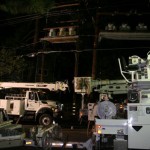The recently signed memorandum of understanding between state fire agencies and several private environmental groups is intended to build support for prescribed burns throughout the state.
Cal Fire and the U.S. Forest Service took the step to help build support for the use of fire as a wildland fire-protection tool. The two agencies, along with the U.S. National Park Service and Sierra Forest Legacy, the Sierra Nevada Conservancy, the Wilderness Society, the Nature Conservancy, the Sierra Club, the Center for Biological Diversity, and the Northern California and the Southern Sierra Nevada Prescribed Fire councils, signed the MOU last fall.
Two local firefighters agree that it is positive step; they feel quite comfortable and confident using prescribed burns in Southern California.
Fuels managers Stephen Fillmore of the Cleveland National Forest and Dan O’Connor of the San Bernardino National Forest were glad to hear about the signing of the MOU. But they were busy watching prescribed burns the same day they were interviewed.
Both advocated using more burns and expected that to continue in the future. While the details of the MOU had not filtered down to the individual forests, the two managers both agreed that there is much cooperation among agencies and environmental groups about the value of this tool.
The intent of prescribed burns is to help the forest ecosystem. Fires are a vital part of nature and help control the overgrowth of forest land, which can lead to extreme conflagrations.
Both agreed that even though the two Southern California Air Quality Management Districts cooperated in approving prescribed burns, they felt the San Diego District tended to be a little more lenient, though population densities are greater in the South Coast District.
“The [California Air Resources Board] is supportive of prescribed fire,” Fillmore stressed.
Both men see prescribed burns as beneficial tools for protecting mountain communities such as Idyllwild, Big Bear and Arrowhead. O’Connor said the Forest Service is planning a late spring burn on Thomas Mountain, if weather and other conditions are consistent with burn specifications.










